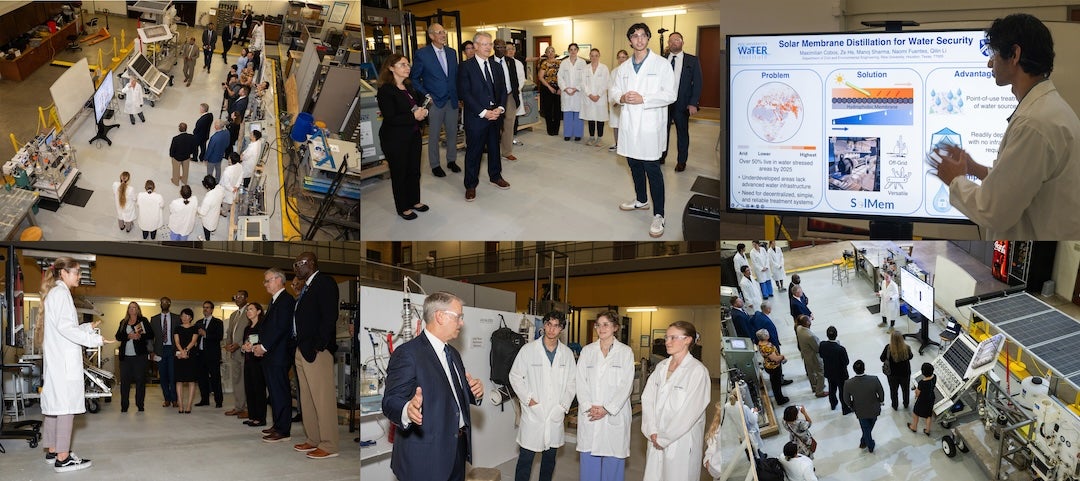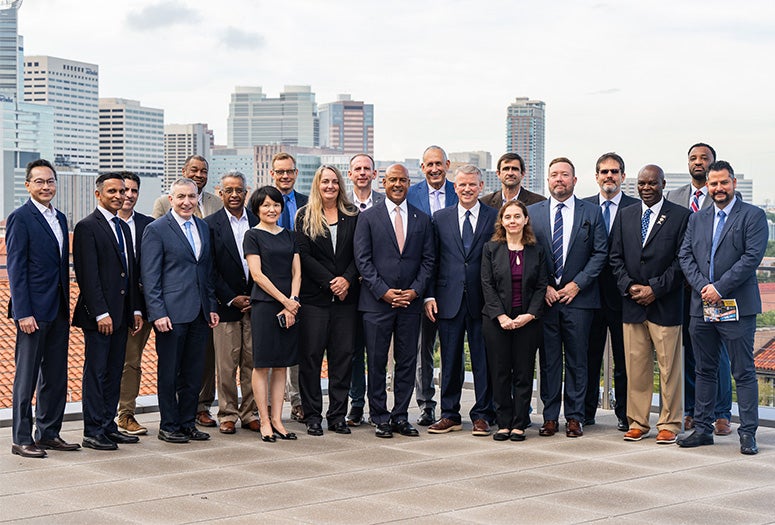Rice University inaugurated a new research center dedicated to per- and polyfluoroalkyl substances (PFAS) Wednesday during a visit to campus by representatives of the United States Army Engineer Research and Development Center (ERDC).
The ERDC delegation, led by agency director David Pittman, was welcomed by Rice President Reginald DesRoches, who said the new Rice PFAS Alternatives and Remediation Center (R-PARC) “builds on multiyear, multimillion-dollar collaborative efforts with ERDC.”

“We firmly believe that Rice is exceptionally well-positioned to develop disruptive technologies and innovations to address the global challenges posed by PFAS,” DesRoches said. “We look forward to deepening our relationship with ERDC and working together to address these critical challenges.”
Pittman, who also serves as the director of research and development (R&D) and chief scientist for the U.S. Army Corps of Engineers (USACE), gave an overview of the USACE R&D strategy, highlighting the importance of a growing partnership between Rice and USACE.

“The sky’s the limit,” Pittman said. “We are constantly looking at how to partner more effectively. There’s a lot more work out there to be done, and you help our nation by helping us do what we do.”
R-PARC will bring together top researchers, industry, policy experts and entrepreneurs to foster collaboration and accelerate the development of innovative solutions to several PFAS challenges, including comprehensive PFAS characterization and risk assessment; contaminated site remediation; water treatment infrastructure upgrades; and the development of safe alternatives.
“The challenge of PFAS cuts across several of the four major research trajectories that define Rice’s strategic vision,” said Ramamoorthy Ramesh, Rice’s executive vice president for research and professor of materials science and nanoengineering and physics and astronomy. “R-PARC will help focus and amplify ongoing work on PFAS remediation at Rice.”

The center is formally housed under Rice’s Water Technologies Entrepreneurship and Research (WaTER) Institute, “a premier innovation ecosystem that develops accessible clean water technologies to enhance human capacity and prosperity.” Launched in January 2024, the WaTER Institute builds on the track record of advancements in clean water technology research and applications established during the decade-long tenure of the Nanosystems Engineering Research Center for Nanotechnology Enabled Water Treatment (NEWT), funded by the National Science Foundation. As part of the WaTER Institute, R-PARC will leverage this history of expertise and benefit from recent institutional investments, including in PFAS-dedicated advanced analytical equipment.
The establishment of the center is framed by a major shift in the U.S. regulatory landscape: Earlier this year, the Environmental Protection Agency issued unprecedentedly stringent standards for some of the most common PFAS, setting the maximum contaminant level at 4.0 parts per trillion for two of them.
“For reference, that represents four drops in 1,000 Olympic pools, such a low concentration that it is very difficult to measure and even more difficult to attain,” said Pedro Alvarez, Rice’s George R. Brown Professor of Civil and Environmental Engineering, NEWT director and director of the WaTER Institute. “Meeting these new standards will not be possible without technological innovation both in terms of mitigation and sustainable alternatives.”

Michael Wong, Rice’s Tina and Sunit Patel Professor in Molecular Nanotechnology, chair and professor of chemical and biomolecular engineering and leader of the WaTER Institute’s public health research thrust alongside James Tour, said, “PFAS decontamination and replacement will entail sustained, long-term effort. R-PARC will serve not only as a gathering point for discovery and innovation, but also as a training ground for the next generation of researchers.”
During their visit, ERDC representatives met with several Rice scholars and researchers involved in work related to the environment, materials and sustainability. In addition to the campus, the delegation visited a number of research facilities and labs, including Tour’s lab, where they witnessed a flash Joule heating (FJH) demonstration.

Tour spearheaded the collaboration with the ERDC in 2021 with a graphene synthesis project, followed by a series of studies that deployed FJH in a range of applied contexts, including the recovery of rare metals from electronic wastes and retired batteries; the conversion of firefighter foams and contaminated carbons from water purifiers into nontoxic substances; and soil decontamination. This body of research enabled the development of three spinoff companies, demonstrating the translational capacity and potential for real-world impact catalyzed by the collaboration.
“We’ve had a long-standing collaboration with the Army Corps of Engineers, particularly the environmental group there, and we’ve published a number of papers together, including on PFAS remediation” said Tour, Rice’s T.T. and W.F. Chao Professor of Chemistry and professor of materials science and nanoengineering. “We hope to expand on this work through this PFAS-dedicated center at Rice.”
In addition to underscoring the potential for an enhanced collaboration on research in national security priority areas, the ERDC visit also reinforced the need for an expanded partnership between Rice and ERDC focused on workforce development. The campus tour included a review of the ongoing Rice-ERDC Education Partnership Agreement signed earlier this year in recognition of their collaboration as part of a multi-institutional program dedicated to providing financial and educational support for students from low-income backgrounds seeking master’s degrees in engineering and related fields.

The last official stop on the agenda for the ERDC delegation was a poster presentation by Rice graduate and postdoctoral students showcasing the alignment of their work with critical USACE areas of interest. The projects on display tackled a diverse range of topics directly related to the agency’s current top 10 R&D priorities.
Pittman addressed the students, saying he had enjoyed spending the day at Rice.
“We discover, develop and deliver new ways to make the world safer and better every day, and that’s what we want you to do,” Pittman said. “We want to hire you. We want to research with you. We’re going to take this relationship to the next level.”

